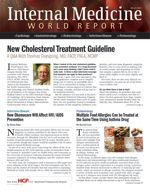Publication
Article
Internal Medicine World Report
Updated Practice Guidelines for Non-Surgical Knee Osteoarthritis Management
Author(s):
New evidence-based consensus recommendations provide guidance for practitioners on non-surgical treatment options that are appropriate or inappropriate for knee osteoarthritis patients.

New evidence-based consensus recommendations from the Osteoarthritis Research Society International (OARSI) provide guidance for practitioners on non-surgical treatment options that are appropriate or inappropriate for knee osteoarthritis (OA) patients.
For the guideline published in Osteoarthritis and Cartilage, the society’s Osteoarthritis Guidelines Development Group (OAGDG) comprised of 1 patient representative and 13 experts from primary care, rheumatology, and other relevant medical fields throughout 10 countries conducted a systematic review of available OA trials and evaluated previous OA guidelines.
Based on that literature, the authors considered a total of 29 treatment tools for their recommendation. To provide practice guidelines applicable to a wide scope of patient profiles and OA burden, the treatment modalities were stratified into 4 clinical sub-phenotypes: knee-only OA without comorbidities, knee-only OA with comorbidities, multi-joint OA without comorbidities, and multi-joint OA with comorbidities. For each of those sub-phenotypes, therapies were recommended as appropriate, uncertain, or not appropriate, and then accompanied by risk and benefit scores on a 1-10 scale.
For all OA patients, the OAGDG endorsed biomechanical interventions, intra-articular corticosteroids, land- and water-based exercise, self-management and education, strength training, and weight management as core appropriate therapies.
In terms of appropriate OA treatment for specific clinical sub-phenotypes, the group recommended acetaminophen, bath therapy, capsaicin, duloxetine, and oral and topical non-steroidal anti-inflammatory drugs (NSAIDs). However, a greater number of treatments were considered uncertain for the sub-phenotypes, including acupuncture, avocado soybean unsaponfiables, chondroitin, crutches, diacerein, glucosamine, intra-articular hyaluronic acid, oral and transdermal opioids, rosehip, transcutaneous electrical nerve stimulation, and ultrasound.

Across the board, risedronate and electrotherapy in the form of neuromuscular electrical stimulation were designated as not appropriate for knee OA patients.
The authors concluded that the updated OARSI recommendations “provide guidance to patients and practitioners on treatments applicable to all individuals with knee OA, as well as therapies that can be considered according to individualized patient needs and preferences.”



























